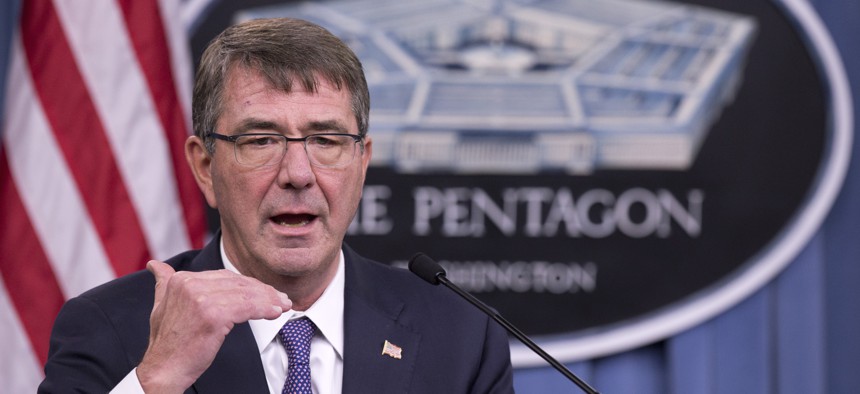
Defense Secretary Ash Carter speaks to reporters, Dec. 11, 2015, at the Pentagon. Manuel Balce Ceneta/AP
Carter May Elevate CYBERCOM to a Full Combatant Command
As network warriors pound away on ISIS in the battle for Mosul, Carter says it’s time to consider full-COCOM status for cyberwarfare.
Defense Secretary Ash Carter is considering turning U.S. Cyber Command into a full combatant command, an acknowledgment that cyber warriors are today not just defending military networks but joining in combined-arms attacks on the enemy.
Pentagon leaders long have said that cyber has joined land, sea, air, and space as a new warfare domain. Especially in cyberspace, Carter said at the Center for Strategic and International Studies in Washington, “our reliance on technology has given us great strengths and great opportunities, but also led to vulnerabilities that adversaries are eager to exploit,”
It is time, Carter said, to “consider changes to cyber’s role in DOD’s Unified Command Plan.”
The military is currently organized into nine COCOMs: six geographic commands (Pacific, Europe, Africa, Middle East, etc.) and three that field specialized capabilities: special operations, nuclear (strategic) forces, and transportation. U.S. Cyber Command, or CYBERCOM, is currently a sub-unified command under U.S. Strategic Command.
“I have given Cyber Command in the ISIL fight its first wartime assignment,” Carter said Tuesday, referring to the historic role that network experts are playing in the Mosul offensive, described primarily as disrupting the group’s communications, command, and control capabilities.
“Increasingly, I’ve brought Strategic Command and Cyber Command into these operations as well to leverage their unique capabilities in space and cyber to contribute to the defeat of ISIL. Beyond terrorism,” Carter said. “A couple of years ago, that would never have occurred to a secretary of defense.”
The calculation has changed largely as a result of ISIS’s own behavior and what the Defense Department perceives as the need to fight ISIS on the group’s own turf, inside online communications networks. He described the thinking as: “Hey, these guys are using this tool. We need to take it away.”
Adm. Michael Rogers, commander of Cyber Command, told the Senate Tuesday morning his unit was ready for the upgrade. Appearing before the Senate Armed Services Committee, he discussed the future of the fledgling Cyber Mission Force and defending networks and as part of the so-called Third Offset, the Defense Department’s bid to develop technologies to secure technological advantage. “USCYBERCOM stands ready to help develop and deploy the new cyber capabilities entailed in the Third Offset, particularly hardened command and control networks and autonomous countermeasures to cyber attack,” he said.
Becoming a Combatant Command "would allow us to be faster, which would generate better mission outcomes,” he said.
